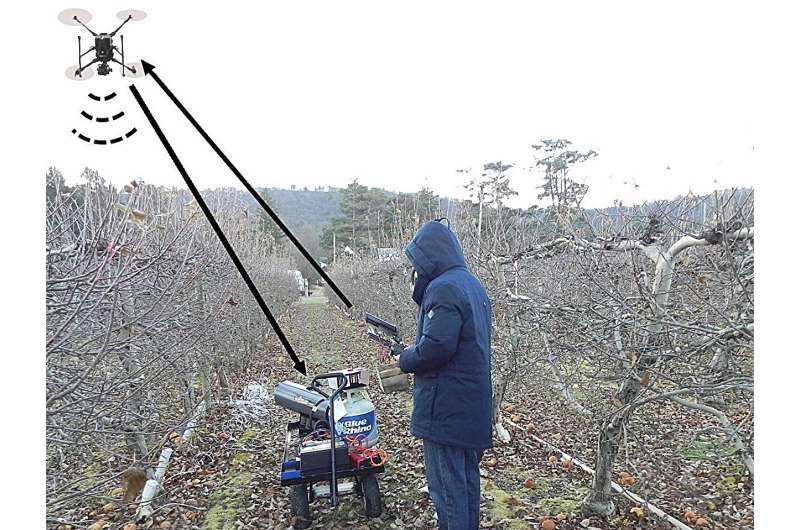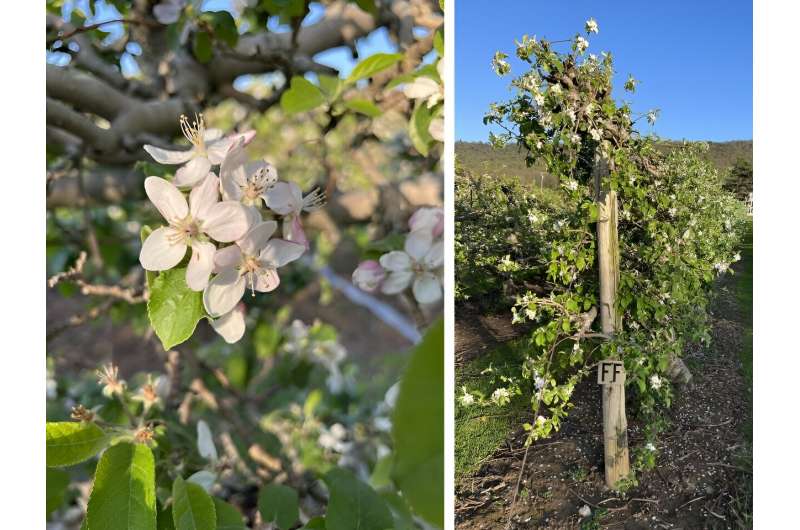This article has been reviewed according to Science X's editorial process and policies. Editors have highlighted the following attributes while ensuring the content's credibility:
fact-checked
trusted source
proofread
Cyber-physical heating system may protect apple blossoms in orchards

Spring frosts can have devastating effects on apple production, and a warming climate may be causing trees to blossom early, making them more susceptible to the damaging effects of extreme cold events. Growers' attempts to prevent the flowers from freezing by attempting to heat the canopies of their orchards largely have been inefficient.
To deal with the worsening problem, Penn State researchers devised a frost protection cyber-physical system that makes heating decisions based on real-time temperature and wind-direction data. The system consists of a temperature-sensing device, a propane-fueled heater that adjusts its direction and angle automatically depending on wind direction, and an unmanned ground vehicle to move the heating system through an apple orchard.
Recently published in Computers and Electronics in Agriculture, the findings show that the cyber-physical frost-protection system greatly reduced damage to apple tree buds in two tests conducted in low temperatures. Compared to similar unprotected orchard sections nearby, deploying the cyber-physical frost-protection system in one test more than doubled the time the test-area canopy was protected, and nearly tripled the time in another.
Applying heat is one of the most effective methods to prevent apple flower bud damage, however growers struggle to determine when and where to apply heat in their orchards, according to researcher Long He, assistant professor of agricultural and biological engineering, who is corresponding author on the study. They often don't have an available labor force to accomplish the heating, he said, leading to either diminished apple crops or energy waste.
Growers know that apple flower buds can be damaged when the temperature falls below 30°F, but they are deterred from taking active protective actions because wind can make heating efforts ineffective.
"Wind is often treated as an uncontrollable factor when growers are implementing heating tasks in orchards because it greatly affects heating performance," He said. "To overcome the challenges growers face, we developed a system capable of monitoring the environment and taking actions in response to the monitored data, using temperature and wind sensors to perceive environmental changes and then make corresponding heating decisions."
This study, which took place at Penn State's Russell E. Larson Agricultural Research Center, was just the latest conducted by the research group focused on smart agriculture in the Department of Agricultural and Biological Engineering. First author Weiyun Hua, a graduate assistant, first determined heat-transfer patterns in an apple orchard utilizing images captured by an aerial drone-based thermal camera and a validated numerical model.
She then incorporated the findings of earlier published research, conducted by the group that created an algorithm to identify apple flower stages and developed a critical-damage temperature map that was made using an aerial drone-based camera. That research also used a drone-based thermal image camera to determine a temperature map, which was used to generate a heat-demand map. Hua used all that information to plan the path for the unmanned ground vehicle to accomplish heating tasks.
The total cost of equipment used to build the test unit in this study was approximately $5,000, Hua noted, mainly including the vehicle for $4,500, the heater for $200 and microcomputers for $100.
"Mostly, the parts were available off the shelf," she said. "The unmanned ground vehicle is an electric lawnmower, with the seat and mower deck removed and the autonomous controls installed. The heater we used was a commercial heater, but it wasn't an orchard heater, it was an indoor space heater. So, the fabrication I did was primarily modifying small components to tie the system together."

One especially innovative aspect of the system was the component Hua devised to automatically rotate and adjust the heater. The researchers learned from the developed numerical model that they needed to apply heat against the background wind direction to reduce heating loss from the orchard. And previous research had shown that an angle of 15 degrees—roughly pointing to the two on a clock face—between the heater outlet and the tree row provided maximum energy utilization.
"We wanted to make sure that the air temperatures got above those damaging critical temperatures for apple blossoms," Hua said. "If the heater is pointed in a direction where it's flowing with the wind, the heat moves out of the orchard very quickly. But if we rotate it—so it's facing more into the wind—then the heat gets more widely distributed."
Research team member Paul Heinemann, professor of agricultural and biological engineering in the College of Agricultural Sciences, noted that more research is needed to propel this technology into the marketplace and make it available to apple growers. But he said he believes this study shows proof of concept and demonstrates what is possible.
"One of the things that we got from this project is, if you had a very large orchard, you could have path-planning involving multiple units with multiple heaters running between the tree rows guided by an aerial drone monitoring the canopy temperatures," he said.
"The aerial drone would send a signal to a heating unit vehicle that says, 'drive over to this place, because it's getting too cold there." And then it could tell a different heater unit to go to another spot. From the models, we know how much heat needs to be put in there, and how long it will take before it cools down again."
That would ensure that there's no conflicts, preventing two units from going to the same place, Heinemann added.
"This research shows we can enhance the efficiency of using multiple heaters around an orchard, using less energy to heat but ensuring that we're hitting all the cold spots," he said.
More information: Weiyun Hua et al, Canopy protection cyber-physical system (CPCPS) for smart agricultural management of frost damage in apple orchards, Computers and Electronics in Agriculture (2024). DOI: 10.1016/j.compag.2024.108611
Provided by Pennsylvania State University





















